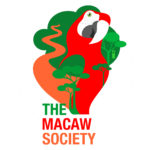The Macaw Society

College Station, Texas, United StatesBiodiversity, Biology, Conservation, Ecology, Environment, Nature & Wildlife, Research
The Macaw Society has been working in the lowlands of southeastern Peru for more than two decades. Drs. Brightsmith and Vigo-Trauco are now leading its expansion to new areas in the Neotropics through a broad array of collaborative projects focused on the ecology and conservation of psittacines.
We study the various aspects of the ecology of large macaws and parrots to help us better understand the interactions among food supply, breeding season, breeding success, clay lick use abundance, and ladscape movements.
Objectives:
1. Develop and test management techniques for use by parrot projects globally
We have lots of experience developing the management techniques needed to help the recovery of wild macaw and parrot populations. We have been successfully using nest boxes and foster parent techniques to help increase reproduction and habitat management techniques to help preserve clay licks and palm swamp nesting areas.
2. Publish studies on parrot ecology and conservation science
As of 2022, we have almost 70 peer-reviewed scientific articles published about psittacines from Peru, Costa Rica, USA, Guatemala, and Mexico (considering only publications with Dr. Don Brightsmith as an author). This includes 41 publications with data from Tambopata and 28 including data collected by volunteers.
3. Train new generations of conservation scientists
We work closely with young national an international assistants to help them gain the skills they need for conducting research. Students interested in conducting their own independent studies for coursework, or theses at the undergraduate, master, or doctoral levels are encouraged to apply to study one of the many aspects of macaw and parrot biology at our research sites in Peru (Tambopata) or Costa Rica (Central Pacific Coast).
